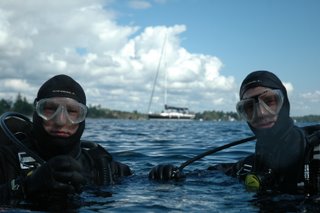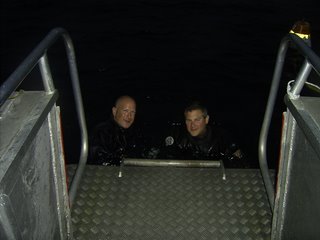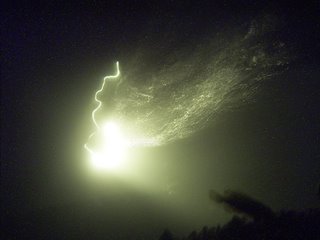 After leaving NY, we headed to Kingston, Ontario, and met the other divers for another shore dive, but this time from the Canadian side and in the lake. I called this one the "waste of time" dive in my log, because it was just that. In reality, its called "two anchors and stacked hulls". You follow a line out to two large anchors, pass a stop sign in 20' of water with a scuba warning, the remnents of an old lounge chair, and eventually to the two hulls. I ventured out for 13 minutes and turned around. Other divers made it out there, but it was the longest underwater swim to nowhere I've ever done.
After leaving NY, we headed to Kingston, Ontario, and met the other divers for another shore dive, but this time from the Canadian side and in the lake. I called this one the "waste of time" dive in my log, because it was just that. In reality, its called "two anchors and stacked hulls". You follow a line out to two large anchors, pass a stop sign in 20' of water with a scuba warning, the remnents of an old lounge chair, and eventually to the two hulls. I ventured out for 13 minutes and turned around. Other divers made it out there, but it was the longest underwater swim to nowhere I've ever done.August 25. Now the real diving begins. The Munson was a two story wooden dredge which sank in 1890. There are tools of the trade lined up to see, a pile of china in the center, and a large shovel/bucket for dredging hanging over one end. The condition of the wood is good due to the cold fresh water. Zebra mussels cover most of the structure. I hit a max. depth of 105' and had a bottom time of 33 minutes.
Next was the Wolf Islander II, which was the first artifical reef put down in Lake Ontario. They say it was put down for scuba diving, and it shows. It looks like a small freighter, or an ice breaker. On the deck was a bicycle, a motorcycle, and a bowling ball. My dive buddy Scott and I went down a shaft into the engine room, and did many swim-throughs and penetrations on this dive. Depth for me on this one was 72' with a 44 minute bottom time.
August 26. We hit the George A. Marsh, which was a wooden schooner that went down in 1917 with 12 fatalities. This is a fully intact wooden wreck, but oddly enough, you can't go inside. The inside of this one is completely filled with silt. There are deadeyes, blocks, pottery, and the ships wheel on the wreck, as well as an assortment of odds and ends. I hit a max. depth of 80' on this one with a bottom time of 48 minutes.
Next stop was the Comet,
 which was a side wheel steamer sunk in 1861 with three fatalities. The majority of the structure has collapsed, but strangely enough, the two large wheels are intact and upright. This makes for some outstanding photo oportunities. We were able to penetrate underneath the decking with only about two feet of space above and below. Max. depth for me on this one was 80' with a 47 minute bottom time.
which was a side wheel steamer sunk in 1861 with three fatalities. The majority of the structure has collapsed, but strangely enough, the two large wheels are intact and upright. This makes for some outstanding photo oportunities. We were able to penetrate underneath the decking with only about two feet of space above and below. Max. depth for me on this one was 80' with a 47 minute bottom time.Night dive time!!!!
 We opted for the Wolf Islander again, and motored out there for an 8:30 splash-in. We waited for it to be nice and dark before entering. Scott an I were the first in, and we were accompanied by Joe. This was what night diving is all about. Watching the lights of other divers, penetrating into room which were completely dark, hearing the thumping sounds made by the exhaled air hitting the ceilings in the rooms, watching rust falling like rain...it was outstanding. Rob took my camera and anchored himself on one of the railings which overlooked the main deck.
We opted for the Wolf Islander again, and motored out there for an 8:30 splash-in. We waited for it to be nice and dark before entering. Scott an I were the first in, and we were accompanied by Joe. This was what night diving is all about. Watching the lights of other divers, penetrating into room which were completely dark, hearing the thumping sounds made by the exhaled air hitting the ceilings in the rooms, watching rust falling like rain...it was outstanding. Rob took my camera and anchored himself on one of the railings which overlooked the main deck.  He put the camera on an eight second shutter, and made the dive lights into art with the camera. Thanks Rob. Max. depth tonight was 76' with a 46 minute bottom time.
He put the camera on an eight second shutter, and made the dive lights into art with the camera. Thanks Rob. Max. depth tonight was 76' with a 46 minute bottom time.August 27. Bad weather prevented us from making the trip to the "City of Sheboigen". The Captain wanted to call the dive entirely, but our trip leader convinced him to take us to the sheltered Wolf Islander II for a third time. We weren't the only ones to think of this, because when we arrvied, we found two other boats moored to the site. Scott, Joe, and I were the first down, and we went straight for the engine room. We dropped down the shaft and did a full exploration of the engine room. I found there was a door which exited out to a side walkway. I also found a small door which went to a lounge area with a bunch of wooden benches. I squeezed through and motioned for Joe to join me. He tried a few times, and eventually made it in after I told him to twist sideways. His wings on his BC were catching on the sides. The doubles made it though with an inch on each side, but with the air in his bladder, he couldn't make it through without a little adjustment. Scott joined us as I went down a set of stairs to a smaller room. Once there, I was give three options. Left into a smaller room, straight to an exit to the walkway, or right through a narrow hallway which leads to another exit. Scott and Joe took this narrow hallway and I was about to follow. I felt something on my fins and noticed another dive team right on me. By the time I turned back to the hallway, Scott and Joe were gone. I noticed two spikes, about two inches long, protruding from the walls into the hallway. I then took the easy way out and exited this area through the door in front of me instead of taking the hallway. Upon exiting, there was Scott and Joe waiting for me. We discussed this exact scenario before entering, and they knew where to find me if I didn't follow. Perfect. I then found the smoke stack and went in fins first. All that was showing was from my chest up. Joe got a chuckle. Then I took the bicycle for a "ride" by hopping around the deck while really making a mess of the viz. Max. depth today was 69' with a 51 minute bottom time.
On the way home, we stopped in Alexandria Bay, NY, for a second dive on the Islander. This was to be a "bottle" and artifact dive. We arrived to find 21 divers on the surface (in and out of the water), and bubbles coming from the wreck. There were a few classes going on, but we decided to dive anyway. By the time we got in, most had cleared out. We went to work and really did a good job at completely destroying any viz. there was. We each found a place to dig, and went nuts looking for anything. I found a semi-old bottle which was not worth keeping. Justin went about 200 feet downstream and found a nice soft spot in the silt. He plunged his arm in as far is it would go until his head was buried. Sure enough he came up with gold. Well, not really gold, but he found a really nice very old clear bottle with designs all over it. He also found a thermometer which was about two feet long. The glass was intact and still contained the mercury. There was an advertisement on the front which was still very readable. He found two nice old pieces. My max. depth was only 40', but I logged a full hour on the bottom.
I got a total of ten dives in four days, with just over 7.5 hours of bottom time. I got a few decent pictures, but now realize that my camera lacks one basic thing.....like a competent operator. Thankfully, Rob had his real underwater camera and took a few for me.
No comments:
Post a Comment